Students petition for meal swipes system
A Change.org petition advocating for the switch has accrued over 750 signatures.
Celia Woodruff assistant news editor
Students have been signing a petition in favor of changing Binghamton University’s meal plan system.
A group of nine students have started a to change BU Dining Services’ (BUDS)

Volleyball hosts America East tour nament
Despite loss, Bearcats continue season at National Invitational Volleyball Championship.
For the first time in program history, the Binghamton volleyball team hosted the America East (AE) tournament over the weekend. While the Bearcats were the No. 1 seed entering the tournament, they had several players unable to play, including all-conference freshman setter Lottie Scully. After beating UNH twice during the regular season, BU was unable to replicate its success, dropping the semifinal match in three sets.
“It’s disappointing for us, but it just wasn’t our day,” said Binghamton head coach Allie Yaeger. “We didn’t execute today. We talked all week about the serve and serve-receive game, and it just wasn’t there for us today. We were out of system so much in the first and second set … [UNH] did an outstanding job with their serve and pass game, so I feel like that’s where they beat us.”
Binghamton (17-8, 8-2 AE) came out of the gates slow, as the Wildcats (20-8, 6-4 AE) opened the game with a 4-0 run.
current meal plan system from a payper-item system to a “meal swipes” system. The petition, posted to Change. org three weeks ago, has accumulated 466 signatures as of Nov. 16, and aims to address theft in dining halls and the affordability of food items. Multiple other schools that use Sodexo as their dining provider have meal swipes systems in place, including the University at Albany and Stony Brook University.
The group of students behind this petition include three freshmen —
Amelia Kongevold and Natalia Pecheny, both majoring in psychology, and Luna Azcurrain, an undeclared freshman — as well as four sophomores — Angelica Rao and Rebecca Kaufman, both majoring in psychology, Ava Kiner, a double-major in psychology and women, gender and sexuality studies and Azaria Walker, who is majoring in philosophy, politics and law. Two seniors also are also behind the petition — including Sophia Richardson, a double-major in biology and women, gender and sexuality studies and Kaylei
Raefski, a double-major in political science and Spanish.
The students stated that their main concern with the current meal plan system is its tendency to “push students toward unhealthy eating habits.”
“Less nutritious items, like french fries and macaroni and cheese, are the only foods that would be able to sustain a budget as restrictive as [$8] a day for [three] meals a day,” the group wrote in a statement.
see petition page 3
Student Association leads holiday food drive
The Student Association is collecting goods to donate to Binghamton shelters and churches.
Tresa Karnati news contributor
The Binghamton University Student Association (SA) is hosting a Holiday Food Drive for Binghamton shelters and churches.
This holiday season, the SA is collecting nonperishable goods, dry food and hygiene products to donate to charity. Donations are being collected in bins placed outside of the offices of some SA-affiliated organizations on campus and given to the Rescue Mission and Main Street Baptist Church to be distributed to community members. The Thanksgiving portion of the collection will take place from Nov. 9 to Nov. 23.
Boxes for nonperishable food donations are set up outside of the SA office, University Union West (UUW) 203, UUW 208B and University Union B19.
BU launches cybersecurity training
After numerous cyberattacks, the course was created to educate the campus community.
20, 2022, under “KnowBe4” on the MyBinghamton portal. KnowBe4 is a security awareness training platform that creates simulated phishing attacks.
Hallie
Milligan news intern
After repeated incidents of cyberattacks, Binghamton University has launched an online cybersecurity training.
The training — titled the 2022 Kevin Mitnick Security Awareness Training — was released to students, faculty and staff on Oct.
Featuring a demonstration Kevin Mitnick, KnowBe4’s chief hacking officer, and Phil Hendrie, an improv voice actor from the Adult Swim show Rick and Morty, the 15-minute course teaches various cybersecurity precautions that can be taken to avoid cyberattacks against an individual or an organization.
Michael Behun, chief information security officer at BU, discussed the
precautions Information Technology Services (ITS) has taken — such as installing the cybersecurity training and a new firewall — to protect students, faculty and staff from future threats. Behun described the attacks as a possible danger to everyone.
“Cybersecurity is an issue for all of higher education, not just [BU],” Behun wrote in an email. “Cyberattacks are continuous and cyber risks are everywhere. We take these matters very seriously and regularly assess and update our security strategies and make
enhancements to mitigate cyber risks.”
The course described how malware, which is “malicious software,” can infect a victim’s computer, allowing attackers access to various computer functions including the camera, usernames, passwords and more.
One type of malware that has impacted the University is ransomware attacks. According to the course, a ransomware attack is when an attacker has stolen files that will be returned in trade for money.
BBDA’s Royal Ball is a regal success
BBDA presented a variety of dance performances and lessons.
The Binghamton Ballroom Dance Association (BBDA) transported Binghamton University students, family and friends back to 19th-century royalty with their Royal Ball event this past Friday.
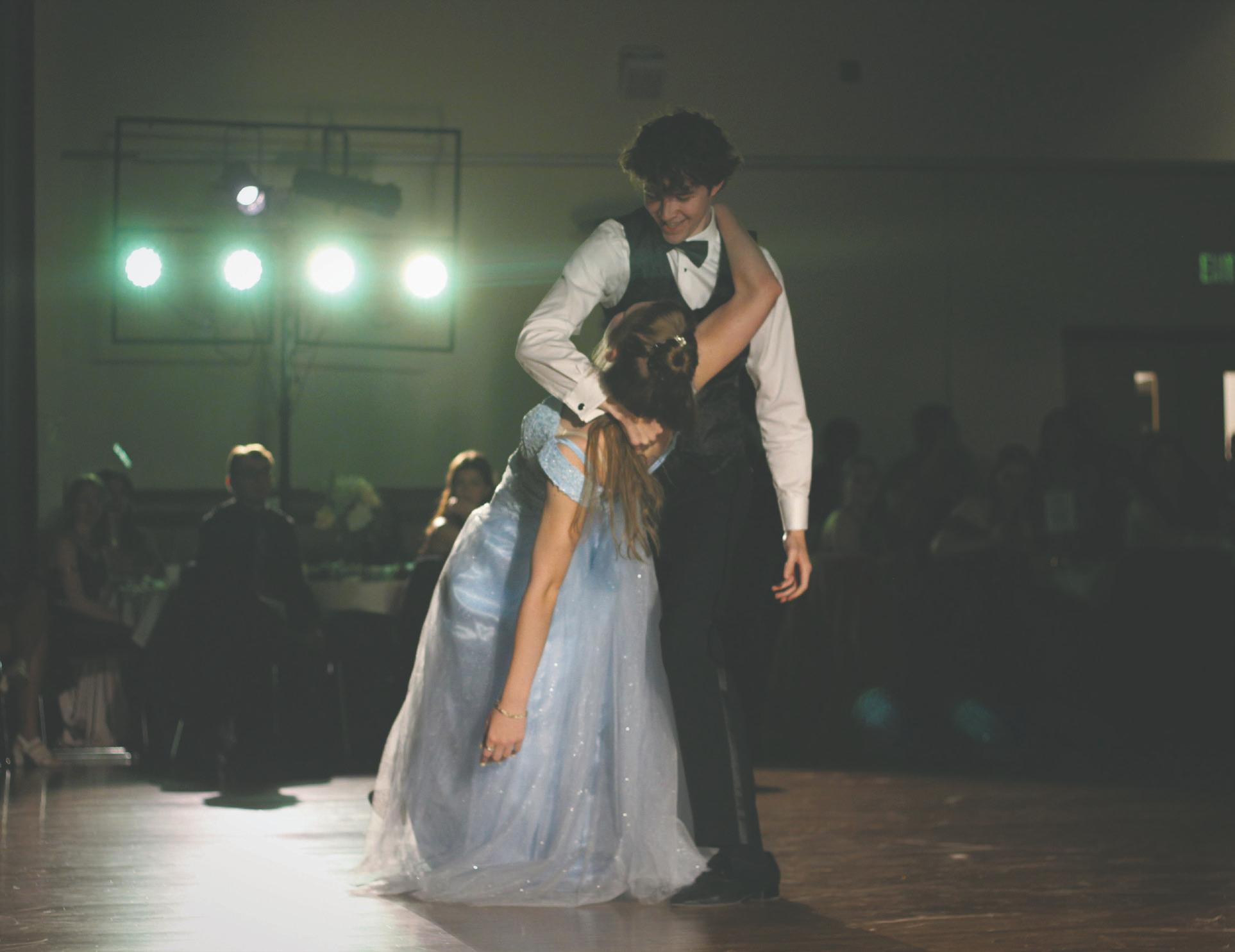
The event — hosted in the Mandela Room — featured musical and dance performances from members of the ballroom team, as well as a waltz dance lesson and a buffet.
The event opened with a performance from several of the ballroom team members as they performed a waltz to Klaus Hallen Tanz Orchester’s “Ständchen.”
The dance was a major feat in choreography and execution, as the several pairs of dancers on the floor were in synchronization with their timing and symmetric in their placement around the center of the dance floor.
ARTS & CULTURE
OPINIONS
SPORTS SEE PAGE 7 SEE PAGE 10 SEE PAGE 9
BUMP show hosts DJ Ambrosia and Blue Hawaii,
NSA hosts biannual semester show,
Guest Columnist Emily Blakely calls for the protection of graduate students,
Wrestling competes against nationally ranked teams,
SEE PAGE 7 SEE PAGE 5
Women’s basketball takes narrow 75-72 win over Golden Griffins,
Tuesday,
November 22,
2022
|
Vol. CI, Issues 22 & 23 | Binghamton University | bupipedream.com
The Free Word on Campus Since 1946
see volleyball page 9
see ball page 7
see sa page 3
see cyber page 3
Jack Oh sports editor
Eli Engler assistant arts & culture editor
provided by cinema society
Performances at the Royal Ball included an elegant Viennese waltz to the “La La Land” soundtrack.
call
a
to the ways
pay
their food has received 466
caspar carson photo intern The
for
change
students
for
signatures since it was created.
Word on the Street
Q: What’s your favorite Thanksgiving dish?
A: “Mashed potatoes because you can’t mess that up. It’s so hard to mess up mashed potatoes.”
Q: What are you doing for Thanksgiving break?
A: “I’m going to be seeing my friends from home and then helping my mom with Thanksgiving, and you know, whatever – having fun.”
Q: What’s your favorite Thanksgiving dish?
A: “Mashed potatoes, with garlic — they just hit different. Turkey’s a little bit overrated, you know?”
Q: What are you doing for Thanksgiving break?
A: Simply go to family, have a couple bets, drink vodka — we’re Russian, so going to have a couple shots — just enjoy the family.”

a
Q: What’s your favorite Thanksgiving dish?
A: “Turkey and mashed potatoes –it’s undefeated and classic.”
Q:What are you doing for Thanksgiving break?



A: “I’m going to be making my brother really annoyed, and probably pranking my parents – fun things like that.”


Ioakim Marinos
a
freshman majoring in chemistry
Q: What’s your favorite Thanksgiving dish?
A: “Turkey – the drumsticks typically – because I’ve always grown up eating the drumsticks and I’m also a drummer and it’s fun.”
Q: What are you doing for Thanksgiving break?
A: “I’m going home on Tuesday, I’m going to spend Wednesday with friends, on Thursday I’m going to spend the day with family – I’m going to eat with my family – and I’m just going to spend time with my family over the weekend.”
a
majoring in nursing
Q: What’s your favorite Thanksgiving dish?
A: “Ham or lasagna. My family is very Italian so I end up making lasagna into the turkey every year”
Q: What are you doing for Thanksgiving break?
A: “I’m getting together with all my cousins — they go to college all over — so it’ll be nice to hang out.”
Q: What’s your favorite Thanksgiving dish?
A: “Mac and cheese. It’s just a classic staple.”
Q: What are you doing for Thanksgiving break?
A: “Go see my grandparents, stay with them.”

a
Q: What’s your favorite Thanksgiving dish?
A: “Probably the turkey, especially when it’s shared with my family.”
Q: What are you doing for Thanksgiving break?
A: Go home, spend time with my family and come back up here, take some finals and head back.”
Harper Edge Art Gallery Walk
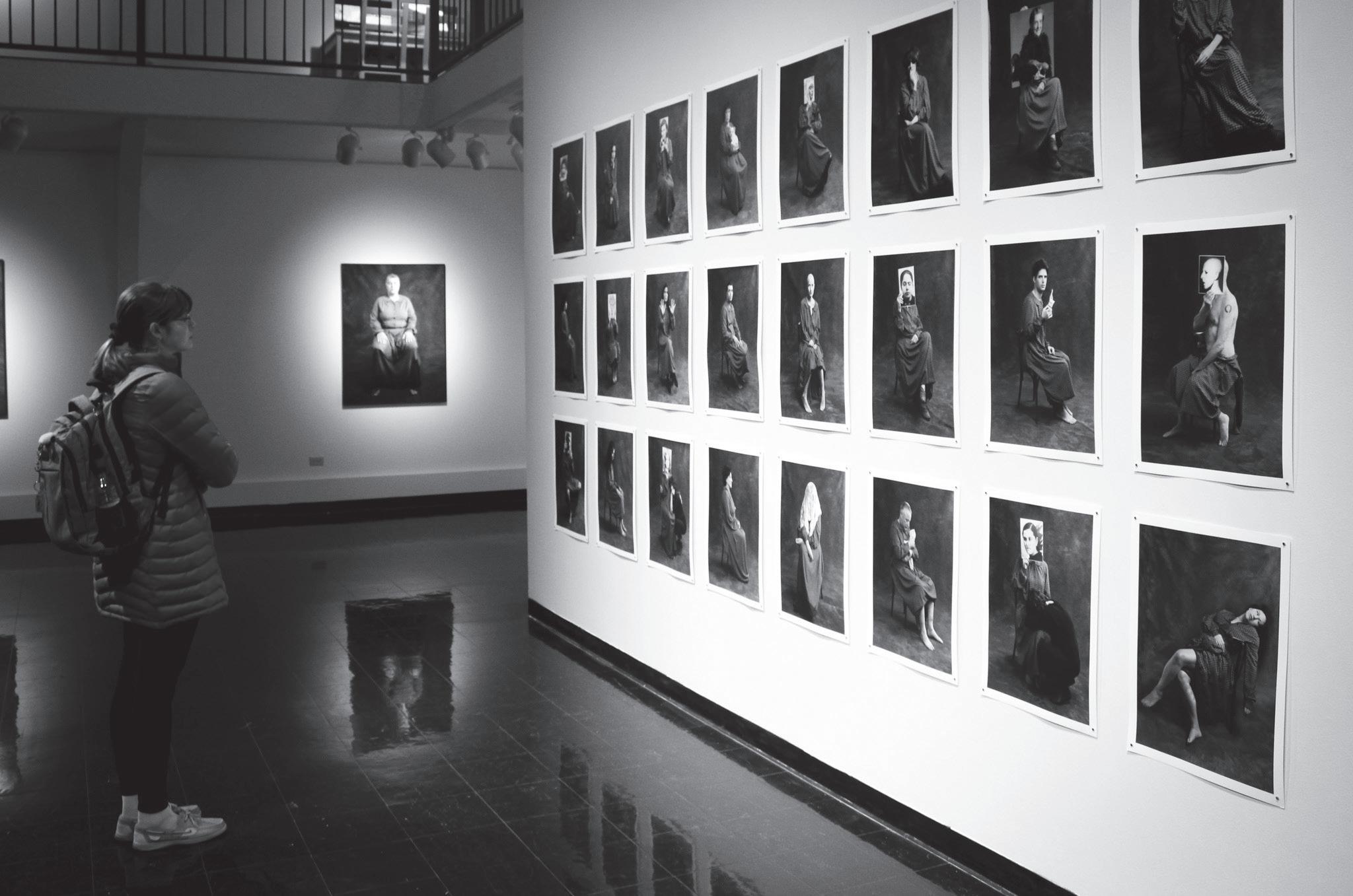
Monday, April 3, 2017 Thursday, September 28, 2017 Monday, October 2, 2017 Thursday, October 5, 2017 PAGE II Fall 2022 Business Manager* Lukas Ladekarl business@bupipedream.com Managing editor Harry Karpen manager@bupipedream.com Editor-in-Chief* Hamza Khan editor@bupipedream.com news editor Jacob Knipes news@bupipedream.com asst news editors Melissa Cosovic Celia Woodruff asst arts & Culture editors Jamie Nguyen Eli Engler sports editor* Jack Oh sports@bupipedream.com Fun editor Peter Proscia fun@bupipedream.com design Manager Bella Daidone design@bupipedream.com design assistants Brianna Crowther Sonia Leyvi Alexa Valadez photography editor* Michael Golann photo@bupipedream.com Copy desk ChieF Lia Richter copy@bupipedream.com teChnology Manager Steven Yeung tech@bupipedream.com asst teChnology Manager Leora Dallas asst. Copy desk ChieF Allison Peteka asst sports editors Michael Carbone Ian Mills arts & Culture editor* Sam Lillianthal arts@bupipedream.com opinions editor Doris Turkel opinions@bupipedream.com asst photography editor Mason Brody-Lewis asst opinions editor Desmond Keuper asst. Business Manager Adam Perez businessassistant@bupipedream.com address: University Union WB03 4400 Vestal Parkway E. Binghamton, N.Y. 13902 p 607-777-2515 weB bupipedream.com stabilizing:pinochole schedule:destabilizing Pipe Dream is published by the Pipe Dream Executive Board, which has sole and final discretion over the newspaper’s content and personnel. Positions seated on the executive board are denoted by an asterisk. Pipe Dream is published online Mondays and Thursdays while classes are in session during the fall and spring semesters, except during finals weeks and academic breaks. The content on the Opinions page with bylines represent the views of those authors and do not necessarily represent the views of the Pipe Dream Executive Board. The content of advertisements do not necessarily reflect the views of the Pipe Dream Executive Board. We reserve the right to reject ads for any reason. All letters submitted for publication must include the author's name, year and major. Please limit letters to the editor to 400 words and guest columns to 750 words. Pipe Dream reserves the right to edit submissions, and does not guarantee publication. All submissions become property of Pipe Dream. Guest column submissions may be emailed to the opinions editor at opinions@bupipedream.com, and all letters to the editor may be sent to editor@bupipedream. Tuesday, November 22, 2022
Danielle Huplosky
sophomore
Sean Tripp
freshman majoring in engineering
Sebastian Teuscher an undeclared sophomore
Alexander Peyser
freshman majoring in business administration
Alicia Perros
a sophomore majoring in biology
Evan M Lechowicz a freshman majoring in business administration
editor
michael golann photography
Nov. 17.
The BU Art Museum was one stop on Harpur Edge’s second-annual Art Gallery Walk
on
Students petition for meal swipes system
“Many living on campus rely solely on dining hall services, and it is a simple fact that it is impossible to maintain a wellrounded diet, with enough nutrients and calories, with the current system in place. The price for the average meal plan (Option C) is $2,950, with only $950 available to students after ‘membership fees.’”
All students living on-campus, with the exception of those in the Susquehanna Community and Hillside Community, are required to purchase meal plans, according to the BUDS Meal Plan Options web page. The web page describes BU’s pay-per-item meal plan system as being accommodating of students’ “unique eating habits”, where there are “no lost meals and no limits on how often or when you can dine.”
BU’s Student Culinary Council (SCC), a group of students who advocate for student-dining interests on and off campus, wrote that they plan to bring the petition and its concerns to the University administration.
“Students turning to unhealthy options or eating fewer meals in order to stay within their meal plan is obviously something that no one wants to see and an issue that needs to promptly be addressed,” the SCC wrote in an email. “The goal of SCC is to be the link between the student body and the dining hall administration in order to enable open and honest conversations about food on campus. We have been able to form a close relationship with the administration through our biweekly meetings which are open to all students, and I can say with confidence that they care about the well-being of the students here at BU.”
The group of petitioners, who had reached out to the SCC for support on their project, said they were told their idea may be outside the purview of the SCC’s powers, and that the project may take more time than the group has.
Matthew Keczmer, a sophomore majoring in mechanical engineering, is one of
the 466 students who have signed the petition. While Keczmer is not certain a meal swipes system is the solution, he expressed hope that University administration will address the petition’s grievances.
“With constantly rising food costs, it’s no longer possible for students to properly feed themselves and stay on a budget,” Keczmer wrote. “It also makes no sense to me that most students pay upwards of $3K on meal plans while only a third of that amount is available to spend. Where is the rest going?”
The group of students behind the petition also believe a meal swipe system could increase students’ food choices and decrease the amount of theft in dining halls, according to their statement. They attributed theft in the dining halls to the high cost of items and students being unable to afford three meals every day, and provided a graph illustrating dining hall meal items — such as fruit or salad bar-items — as being four to five dollars more expensive than the average breakfast, lunch or dinner.
Alexandrea Goyette, a junior majoring in environmental science, has not signed the petition but agreed its aim is “a good idea,” citing past incidents of her friends skipping meals in order to budget their meal plan.
“I feel like this way kids wouldn’t be trying to starve themselves just to budget correctly, especially with how expensive the dining hall food has gotten,” Goyette said. “I visited [BU] right before [COVID-19] hit when I was a junior in high school — that was like 2018, it might have been the spring of 2019. I remember when they were talking on tour, they were boasting how you could pay a set amount of money, which was more expensive, but then you got unlimited meal swipes, if that was something you wanted as an option. So they at least had it as an option. And I think [COVID-19] changed a lot of things.”
BUDS did not respond to request for comment.
Nia Johnson, SA president and a senior majoring in human development, said she decided to take on this project as a part of her presidential responsibilities.
“Every year, the president’s office has an initiative they start and complete,” Johnson wrote in an email. “Last year, David Hatami had a winter clothing drive, so this year I thought of having a Holiday Drive which includes collecting both canned goods and hygiene products for both Thanksgiving and Christmas.”
Broome County has a high rate of food insecurity, according to data from Feeding America. In 2020, the food insecurity rate in Broome County was 13.8 percent overall and 19.4 percent for children under the age of 18, surpassing the average rates of food insecurity in New York state — which are 9.6 percent for all individuals and 14.6 percent for children under the age of 18.
Johnson said she was aware of the rates of food
insecurity in Binghamton and took them into account when deciding on her presidential initiative. She chose a food drive with the intent of making Thanksgiving easier for families and Binghamton locals.
Johnson reached out to other student organizations to set up collection boxes outside of their offices. One organization participating in the food drive is Hillel at Binghamton, an organization that, as stated in their mission statement, “seeks to facilitate meaningful Jewish experiences.” Lauren Hollander, Hillel president and a senior majoring in psychology, explained the importance of the food drive to her organization.
“I think it’s such a wonderful initiative that [Johnson] and the [SA] President’s Office are doing,” Hollander wrote. “In Hillel, one of our goals is to give back to the community in whatever ways we can, and to do Mitzvot, or good deeds. Especially during the season of giving, this is a time when our
organization seeks to unify and better both the Jewish community, and the larger Binghamton community as a whole.”
Hannah Gross, a sophomore majoring in integrative neuroscience, who considered donating to the food drive, shared her thoughts on initiatives like the food drive.
“I think it’s good for [BU] students to take an active role in the community that their school is a part of,” Gross said. “As a part of the larger Binghamton community, it makes sense to help out.”
While the SA welcomes any nonperishable goods as donations, feminine hygiene products are in high demand. Feminine hygiene products are not tax-exempt in all U.S. states and are subject to price hikes due to city and county surcharges, according to the BBC. NBC corroborates this, stating that tampons and pads are the least donated items to shelters, forcing people struggling with homelessness to use newspapers or tissues
Student Association leads holiday food drive BU launches cybersecurity training
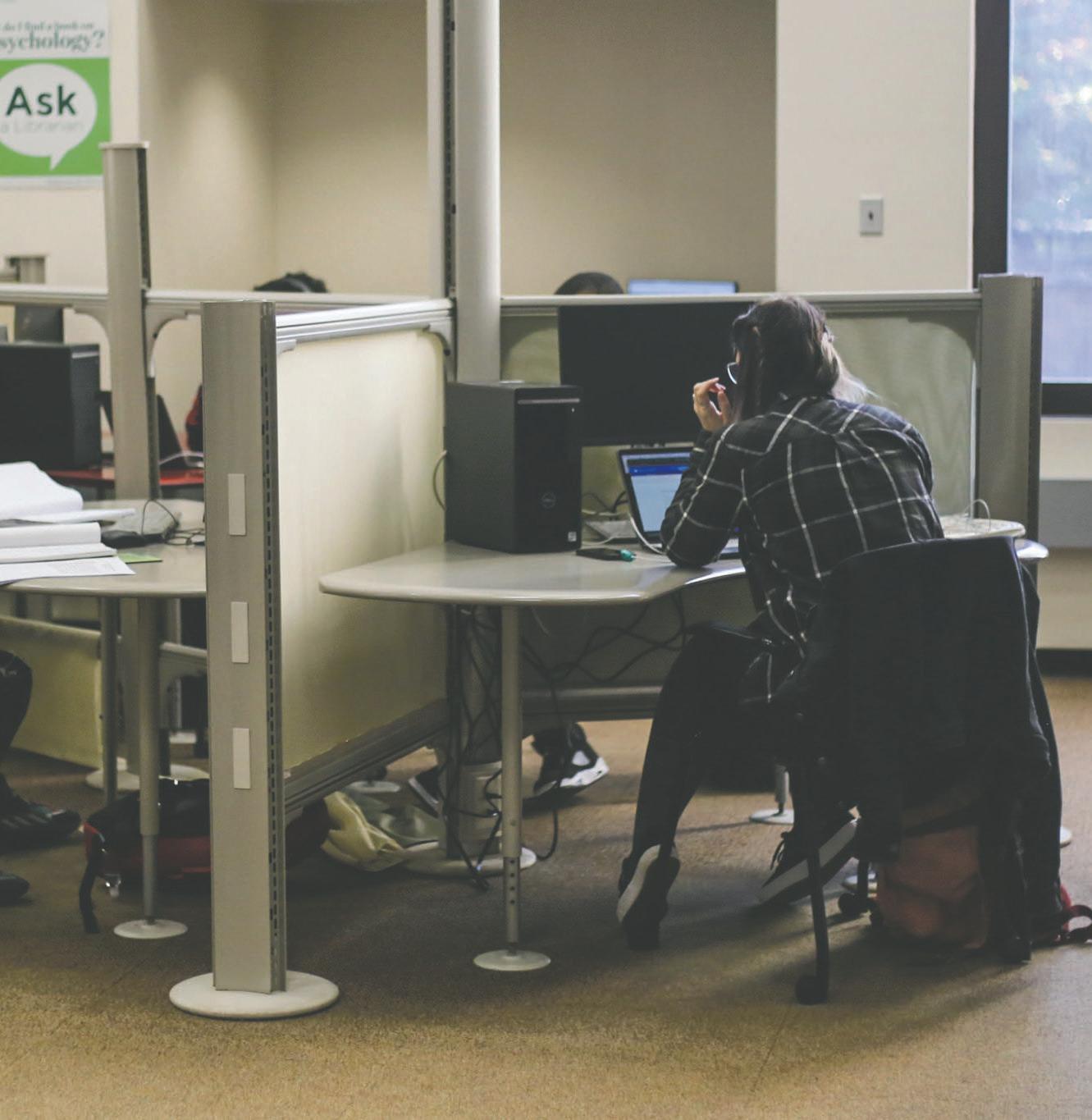
in place of sanitary products.
Johnson explained how the “tampon tax” impacts the lack of sanitary product donations to shelters.
“For this drive we are accepting any hygiene products as well as nonperishables,” Johnson wrote. “We are still in need of more nonperishables and women hygiene products. Women hygiene products are more in demand because they are considered luxury items by the state, so they can end up being very expensive.”
The Christmas portion of the food drive will take place after Thanksgiving break. While there is no explicit donation goal, Johnson hopes to collect as many items as possible.

“My overall hope for this drive is for students to understand the importance of giving back to the community,” Johnson wrote.
“Students can enact change in the community in little ways and I just want this to be one of the many ways [BU] students help the Binghamton community.”
“Ransomware scrambles the data in computer files, making them unreadable,” the course reads. “These locked files are then held hostage by the cybercriminals till a ransom is paid. This type of malware can paralyze your organization by spreading to all the devices and files across your organization’s network.”
Some of these ransomware victims have been professors at the University.
Subimal Chatterjee, area chair of analytics and SUNY distinguished professor in the School of Management (SOM), is one of these professors. Around 25 years of Chatterjee’s research data was stolen in a ransomware attack that happened in February of 2021. Chatterjee described his data as “being held hostage” by the attackers. Both Chatterjee’s desktop and backup hard drive, which were connected to his desktop during the attack, were affected.
Chatterjee said the attack has had an influence on the future of his career, and suggested others learn from his experience with the ransomware attack. He now keeps his files on Google Drive and works mostly from his office on campus to provide protection for his research.
“These are lessons learned the hard way,” Chatterjee said. “Just be careful, assume the worst and take all precautions. You really don’t want
to happen to you what happened to me. It’s a long process, getting some of the research data back. Of course, my co-authors have access to the data so I could get most of it back from them, but there were other pieces of research I had just started by myself, and that data is gone.”
Like Chatterjee, Behun recommended that all students, faculty and staff save their work to another source outside their desktop — preferably Google Drive.
“Everyone has a role to play in cybersecurity,” Behun wrote in an email. “Students can protect themselves and their work from cyber risks by keeping their computer software up to date, protecting their passwords, being wary of scam messages offering jobs or student loans and keeping a copy of their important work on Google Drive.”
Roslyn Chapin, an undeclared freshman, said she was impacted by a WiFi cutout that recently happened at the University, and that the training seems like it would be beneficial for BU should a malicious attack occur.
“I think the program’s great,” Chapin said. “Recently, with the whole WiFi situation, it scared a lot of students, and I think having the knowledge and knowing what to do would be very helpful. I think it should be mandatory.”
The training is set to close on Nov. 30 at 11:59 p.m.
bupipedream.com | November 22, 2022 NEWS 3
petition from page 1
em o’brien design intern
Students are encouraged to donate their nonperishable goods, dry food or hygiene products to donation boxes outside the Student Association office, UUW203, UUW 208B or UUB19.
maribela dias contributing photographer
The online training discusses malware, ransomware, cyberattacks and more.
sa from page 1 cyber from page 1
OCCT Late Nite reopens with new guidelines
After a several-week hiatus, Late Nite was reinstated by the SA.
Adi Kombiyill news contributor
Last Friday, the Binghamton University Student Association (SA) announced the reopening of the Off Campus College Transport (OCCT) Late Nite bus service.

The decision to reinstate Late Nite comes after a severalweek suspension of the service in response to numerous student misconduct incidents — which occurred at the OCCT bus stop on the intersection of State Street and Hawley Street. During the temporary closure, the SA and OCCT staff worked together to form a long-term solution to stop recurring student misbehavior. The solution includes placing barricades and having more police officers at the downtown bus stops.
Students can expect new rule additions from when Late Nite services were last operating, according to the SA’s statement. One of the changes includes moving the bus stop to Parlor City Commons to ensure that less students will overcrowd and cut lines when boarding the bus.
“All buses will now stop and pick up passengers from Hawley Street beside the courtyard immediately behind Stone Fox,” the SA wrote in an Instagram statement. “Barricades with a distinct

queue area will also be placed at this stop.”
Furthermore, the SA and OCCT announced they will be cooperating with both the New York State University Police Department (UPD) and Binghamton Police Department (BPD) officers to guarantee that students adhere to the newly established rules.
“Both BU police officers and the [BPD] will be on the scene to keep everyone safe,” the SA wrote. “Trained OCCT Late Nite staff will also be present at the stops to assist with crowd control.”
OCCT staff has had to deal with overcrowding issues throughout the semester, but decided to make a permanent change following numerous incidents of antagonistic student behavior on Halloween weekend, according to the SA.
Daniel Croce, chairman and chief financial officer for OCCT, SA vice president for finance and a junior majoring in business administration, said that the impact of recent disorderly conduct on OCCT staff and other passengers was one of the main reasons behind implementing the rule changes.
“The disruptions to service were caused by unruly passenger behavior when boarding the bus,” Croce wrote in an email. “This behavior was targeted against both the officers at the scene and drivers, and posed significant safety risks for not just OCCT staff but other passengers as well.”
The most recent suspension of the service marks the third time OCCT has been suspended this semester. Alex Lewyn, a senior majoring in economics, said he thinks student behavior on the buses worsened in the semesters during COVID-19.
“At first during [COVID-19] I noticed drivers struggling with smaller issues such as getting students to wear masks on the bus,” Lewyn said. “Then,
it became a bigger problem on the weekends with everyone pushing each other in line to get on the Late Nite buses.”

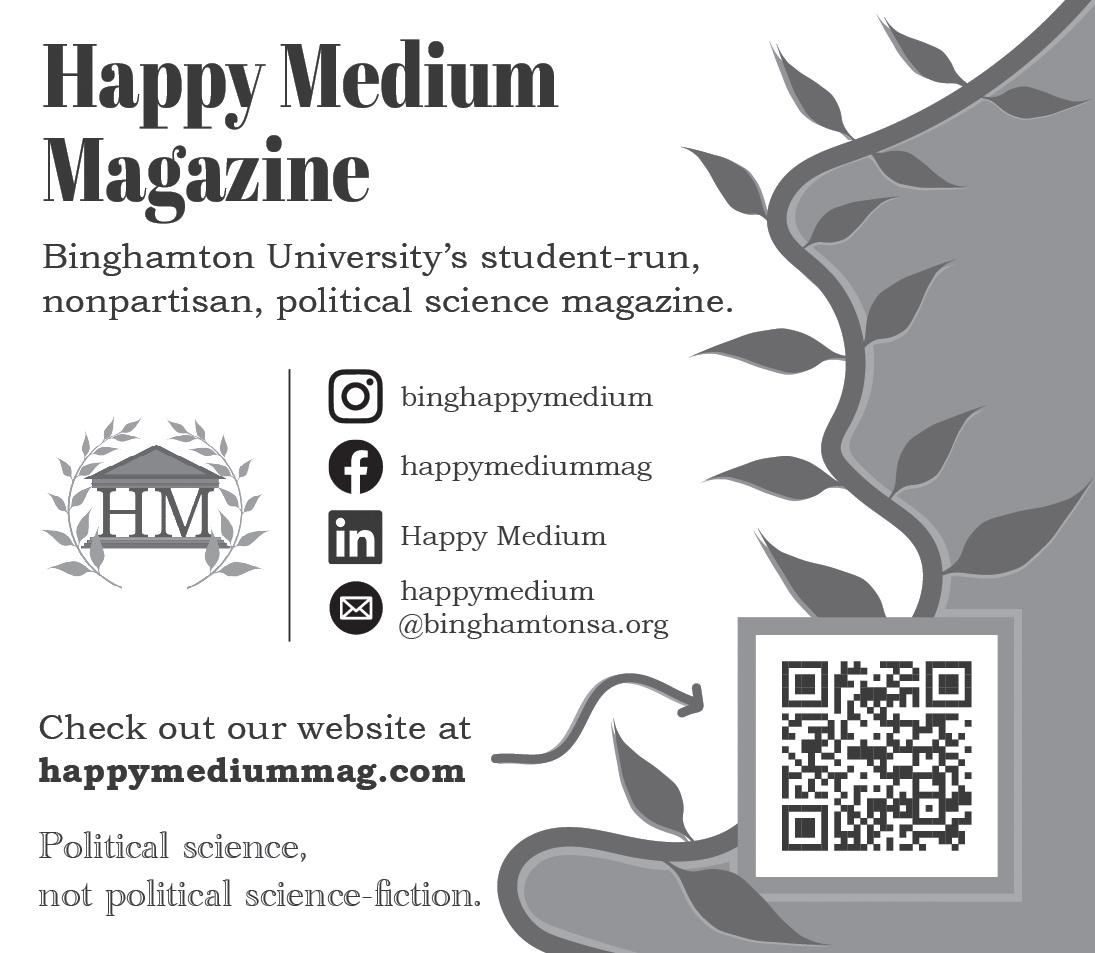


HanChen Liu, a sophomore majoring in accounting, described how the recent suspension of Late Nite services has impacted him on weekends.

“I live off campus and since the Late Nite buses were not running these past weeks, it was
hard for my friends on campus to take the bus to my place on the weekends,” Liu wrote in an email. “I am happy to see the buses resume at these times, and hopefully the schedule can be consistent now.”
The SA has warned that further instances of disorderly conduct from students could lead to a permanent termination of Late Nite services. Croce has called for
continued student compliance in the interest of keeping the buses running.
“Myself and all employees at OCCT have one mission — to get students home and around the Binghamton area safely,” Croce wrote in an email. “I continue to encourage all students to respect staff members, buses and the service. We will get you home safely, and we are truly in this together!”
bupipedream.com | November 22, 2022 NEWS 4
caspar carson photo intern
OCCT is a student-run service that provides transportation to various locations on- and off-campus at no charge.
OPINIONS
BU graduate teaching assistants must be protected
The safety of graduate assistants should
Emily Blakley Guest Columnist

In an academic environment where hate speech and ideals of white supremacy are becoming commonplace, Binghamton University is failing in its duty to protect not just its most vulnerable students from irrevocable harm, but also its most vulnerable employers — graduate student teaching assistants.
In the spring of 2021, a graduate student teaching assistant was referred to by a derogatory racial slur, and the aftermath of this event included an email that reprimanded sociology professor Dr. Price, stating that “everyone has as much of a right to be racist as they do culturally competent,”
and that instructors have a duty to their racist students to make sure they are “able to move through the course and trust they can be treated fairly.” Dr. Price has since left BU.
In defense of graduate student TAs who face hostile and racist students in their classrooms, the Graduate Student Employees Union (GSEU) drafted a petition demanding that BU administration stand by faculty and staff, including graduate student assistants and come up with a plan to address future racism in the class. Over 1,500 members of the University have signed the petition. The petition was met with a reiteration that free speech is a protected right and that University employees are welcome to speak with the Office of Disability and Equal Opportunity on an individual basis.
More recently, a white male
undergraduate economics major by the name of Sean Harrigan released the names of his professor, Ana Candela, and her TAs to the online journal Campus Reform for her use of anti-racism policies in the classroom. Campus Reform is particularly harmful to faculty members, as those whose names have been published face threats via email, social media, physical mail and in person.
Faculty members who are of a marginalized identity and who teach topics of race or politics are more likely to be targeted. In the face of threats, affected faculty frequently reduce their online presence, and some have even switched universities or changed their teaching and research agendas. Harrigan went even further by baiting his graduate TA into a long series of email debates regarding the efficiency of masking during COVID-19
and sharing these personal email exchanges, out of context, with Campus Reform. This prompted xenophobic comments and slurs from readers of the journal, as this TA is an international student. When GSEU reached out to see how the University, particularly Harpur College, planned to protect this TA, we were told that if anything threatening were to happen, we were welcome to contact campus police. That was the extent of the action they were willing to provide. Candela has since left BU.
Even more recently, a BU alumnus by the name of Jon Lizak, who was both a former president of BU College Republicans and integral in bringing Turning Point USA onto BU’s campus, was arrested for violently storming the U.S. Capital. Both Lizak and Harrigan were members of the College Republicans, as were other
students who provided comments to Campus Reform.
These are just two examples in the last year and a half where BU has prioritized the feelings of its white male students over those of its marginalized graduate employees, who often have very little recourse to protect themselves in the classroom. As we just saw with the recent arrest of Lizak and the harm that can come from being targeted by Campus Reform, these are not simply words coming out of the mouths of angry men but are linked to real incidents of violence. The complacency of BU in the face of harm to its most vulnerable is both disheartening and dangerous.
With the current political climate becoming more accepting of bigotry against marginalized folks and educators, often finding themselves on the front lines of
a culture war they are neither trained for nor paid enough for, these incidents will only increase in quantity and severity.
Now more than ever, we need to stick up for our friends and colleagues, our professors, mentors and our students. As the chapter president of the GSEU, to all my fellow graduate employees — we are here for you and we are willing to fight this fight with you. As a teaching assistant, to my students — I will do what I can to protect you and to advocate for you whenever I can. To my mentors, supervisors and professors — graduate students are also here for you and will stand up for your rights and safety.
–Emily Blakley is a cognitive and brain sciences Ph.D. candidate and is the president of Binghamton University’s chapter of the GSEU.
America is at fault for Puerto Rico’s crises
Puerto Rico’s issues are rooted in American imperialism, tourism.
Vega Columnist
It is no secret that Puerto Rico, the small Caribbean island off the coast of Florida, has been struggling with a slew of environmental, political and financial issues since its acquisition by America in 1898.
However, in recent years, Puerto Rico’s structural issues have been especially highlighted by issues such as Hurricane Maria in 2018, the increased curation of perfect coastal tourist attractions at the expense of locals and the presentation of Puerto Rico as a tax haven for the top 1 percent of Americans.
Boricua celebrities have aided in the publicization of these crippling issues. The chart-topping rapper Bad Bunny, for example, did so in his most recent music video, “El Apagón - Aquí Vive Gente” or “The Blackout – People Live Here,” a mini-documentary that exposed the way Puerto Rico is being used for both its beauty and its necessary leniency on the rich. Puerto Rico stands in an odd purgatorial state where a strong sense of cultural and “national” identity is
maintained while also being at the political whim of the United States and having little governmental representation. In order to aim toward a solution for reclaiming the island, it is imperative to realize that the failures of the American government and by extension, the American rich are what have continued to exacerbate these deep-rooted weaknesses within the Puerto Rican community.
The first aspect of the decimation of Puerto Rico’s infrastructure has been the usurpation of public-owned beach land by private companies and foreign-source residents. By law, all beaches are required to have public access, but numerous foreign realestate developers have encroached upon the beautiful locally-owned beaches in order to construct apartment complexes, casinos and beach resorts. People like Maricusa Hernández, who was highlighted in Bad Bunny’s music video, have been issued a 30-day eviction notice after their building was bought by a new owner. Hernández had been living in the building since the 90s — until the owner of the building was looking to raise rent by $2,000.
Additionally, Jorge Luis González, a resident of Puerta de Tierra, told the creators of the music video, “I lived there. For 54 years, I
lived on that corner. Look at it now, a building, a new housing project for the rich. I was born there, and now I can’t go there. Because we’re Black and poor, they’re abusing us, you know?” Mass displacement across the island is only a symptom of the main issue — developers are acting on their belief that Puerto Ricans are disposable and do not maintain rights over the land, which has built and fostered the prosperity of their communities.
On the whole, landlords are not bound to any landlord or tenant laws in Puerto Rico outside their written leases and contracts, which allows for egregious increases in rent that push out generational residents. Any laws that may aid in the defense of the old residents must be pursued through lengthy and expensive legal battles, which generational residents are ill-equipped for. There is a certain inherent disrespect and predatory perspective that informs the way those who are not from Puerto Rico treat its vulnerable and poorer residents.
Over the years, even though they are technically mandated by law, many street-to-beach access paths have been shut down due to these private enterprises, leaving the surrounding beaches as the only way to get to those “privatized”
beaches. This wouldn’t be an issue if the landscape wasn’t so purposefully selected as to have rocks and miles of sand in between the otherwise easily accessible beaches and the beaches enjoyed by high-paying customers, which shows the cruel use of the locals’ own land to create classist barriers.
Furthermore, Act 22 provides tax breaks to the greedy investors of America and serves as an incentive to move in and push out undesired locals. The Act outlines “full exemption from all local taxes on passive income to individuals. Its beneficiaries are not allowed to have lived in Puerto Rico for the last ten years, and have to spend a certain number of days on the island to maintain their status.” The Act was introduced as a response to Puerto Rico’s $72 billion debt crisis, which the island is not able to back up independently of its tourism-dependent economy. Large names such as Logan Paul have since moved to benefit from these laws, which ironically don’t apply to locals. While over 600 schools have closed due to this financial crisis, “4,500 individuals and businesses have relocated their homes or businesses, primarily from the mainland U.S., to Puerto Rico under the Act,” according to
TIME. These desperate attempts to resuscitate the economy of Puerto Rico “coincidentally” only benefit the rich and powerful by giving them an easily accessible tax haven and also come as a direct result of America’s wishy-washy treatment of Puerto Rican residents. Puerto Ricans are U.S citizens, with the right to enlist in the military, but are not given the right to vote in U.S. elections, despite the fact that the U.S. Congress can veto or amend Puerto Rican laws. Where Americans once stood against taxation — and other legislation — without representation, we now find ourselves denying the same rights to the fledgling country.
These structures imposed by the American-run government restrict the economic prosperity of Puerto Rican locals, keeping them vulnerable to external realtors who can buy up their property and kick out those who have lived there for generations. And unfortunately, this doesn’t summarize the entirety of the structural issues on the island. Just this year, Hurricane Fiona caused a near island-wide blackout where 1.5 million people were out of power due to the corrupt practices of the island’s power company, LUMA Energy. At this point, the most important thing one can do
to help the people of Puerto Rico is to make noise, share information and allow the locals to be heard.
For example, in Rincón, the Sol y Playa Condominium was found to be conducting illegal construction and was ordered to tear down the construction within 180 days. However, that deadline came and went without any action from the company or the government, so activists took it upon themselves to tear down the walls and reclaim the beach for themselves and the wildlife. There are many activist groups and political parties — like the Puerto Rican Independence Party (Partido Independentista Puertorriqueño) and Boricua Popular Army (Ejército Popular Boricua) — as well as mass protests like the 2019 “March of the People,” dedicated to organizing against America’s continued mistreatment and disenfranchisement of the people of Puerto Rico. And the people of Puerto Rico are not backing down because, as sung at the end of Bad Bunny’s video, “Esta es mi playa, Este es mi sol, Esta es mi tierra, Esta soy yo.”
Those interested can visit https:// www.prxpr.org/ to see how they can help Puerto Rico.
–Emily Vega is a junior majoring in English.
Samantha Rigante Columnist
The modern factors by which colleges and universities consider potential applicants have essentially always been highly contested. Are objective measures, like test scores, grades and class rank, superior to other potentially subjective criteria, such as personal essays and extracurriculars? That will remain up to individual schools to decide. However, what isn’t at their discretion is whether or not race will soon be ruled unconstitutional to consider in college admissions, a position which will have extremely harmful consequences on the state of diversity in American higher education.
Perhaps unsurprisingly, affirmative action policies — the idea that some sort of preference regarding minorities should be considered in an effort to end centuries of race and sex discrimination within the United States — are not overwhelmingly popular.
Affirmative action’s most hotly contested appearance is within the realm of higher education and college admissions. Specifically, the controversy deals with whether or not race should or even can be considered when accepting or denying potential applicants.
On Oct. 31, the Supreme Court again listened to arguments about whether or not race is a constitutionally legitimate factor to consider when admitting students.
The plaintiff who submitted the specific suits to the Supreme Court is a nonprofit organization titled Students for Fair Admissions, whose selfdescribed goal “is to support and participate in litigation that will restore the original principles of our nation’s civil rights movement.” Students for Fair Admissions filed these actions in 2014 against the University of North Carolina at Chapel Hill — a public institution receiving federal and state funding — and Harvard University, an elite private school. Students for Fair Admissions claimed that the process by which these two specific Universities considered

applicants was unfair and contained racial bias specifically against Asian American, Pacific Islander and white students. They first appealed to lower courts, who rejected their appeal. They then took the cases to the Supreme Court, which will finally decide whether or not race-conscious admissions operations are constitutional.
Affirmative action policies are not a shiningly perfect strategy for increasing diversity in colleges and universities, and multiple issues, including to what extent race is considered over other factors, complicate affirmative action practices. However, completely abolishing affirmative action in the hopes of establishing some sort of “colorblind” admissions policies overlooks the necessity of policies that correct the long history of inequities in the higher education system. The structure of many affirmative action policies and practices may need to be reformed with more focus on economic inequality rather than racial inequality, but outright mandating that race-conscious admissions is unconstitutional is simply not
the answer.
Take the University of California, Berkeley, for example. After California passed Proposition 209 in 1996, outlawing the use of race as an admissions factor at the state’s public universities, the Black student population at the school fell from 6.4 percent to 3.6 percent. At the University of California, Los Angeles, the same phenomenon occurred as the Black and Latino student demographic ratios dropped by almost half. Nearly 20 years later, those percentages have just about reached where they were in 1996.
Diversity has an important place within higher education, as a cornerstone of learning is the consideration of diverse viewpoints and the lived experiences of those that differ from you. Declining numbers of diverse students within higher education institutions are simply unacceptable and, as it seems very likely that the Supreme Court will be overturning and forbidding affirmative action in admissions, schools will rapidly be looking for ways to increase not only racial diversity but
economic diversity as well.
Another controversy besides race within college admissions is legacy. High-income legacy students representing an overwhelmingly large proportion of elite universities has garnered the attention of affirmative action advocates for good reason. Harvard favors students who specifically come from four categories abbreviated as “ALDC”— athletes, legacies, dean’s list students and children of faculty. ALDC students are only roughly 5 percent of all applicants to Harvard, but make up a whopping 30 percent of Harvard’s most recently admitted class, and white students are overwhelmingly favored according to this metric. Additionally, nearly two-thirds of Harvard’s student population come from the highest 20 percent of income earners.
Economic inequality and a lack of resources in middle and high schools in both poorer communities and communities of color are often the biggest drivers of why students of color are a minority in many higher education institutions. As the death of affirmative
action seems forthcoming, elite schools like Harvard should be looking for other means to increase economic diversity — which may also increase racial diversity — that could eventually end up being more effective than affirmative action. These kinds of programs, including expanding financial aid and supporting recruitment processes for low-income students, may increase racial and economic diversity at these types of schools.
Diversity in higher education obviously has a long way to go, but ending affirmative action without any meaningful replacement is not the solution. While schools will be searching for alternatives to maintain their current levels of diversity, all students will be hurt if diversity numbers fall. Including race in admissions categories alongside other factors is something that is a benefit to all, and the Supreme Court’s eventual killing of it will only be to the detriment of the higher education system.
Rigante is a freshman majoring in philosophy, politics and law.
Monday, April 3, 2017 Thursday, September 28, 2017 Monday, October 2, 2017 Thursday, October 5, 2017
Tuesday, November 22, 2022
be prioritized over racist students.
Affirmative action must be preserved Affirmative action’s progress in addressing educational inequity is being jeopardized.
–Samantha
Emily




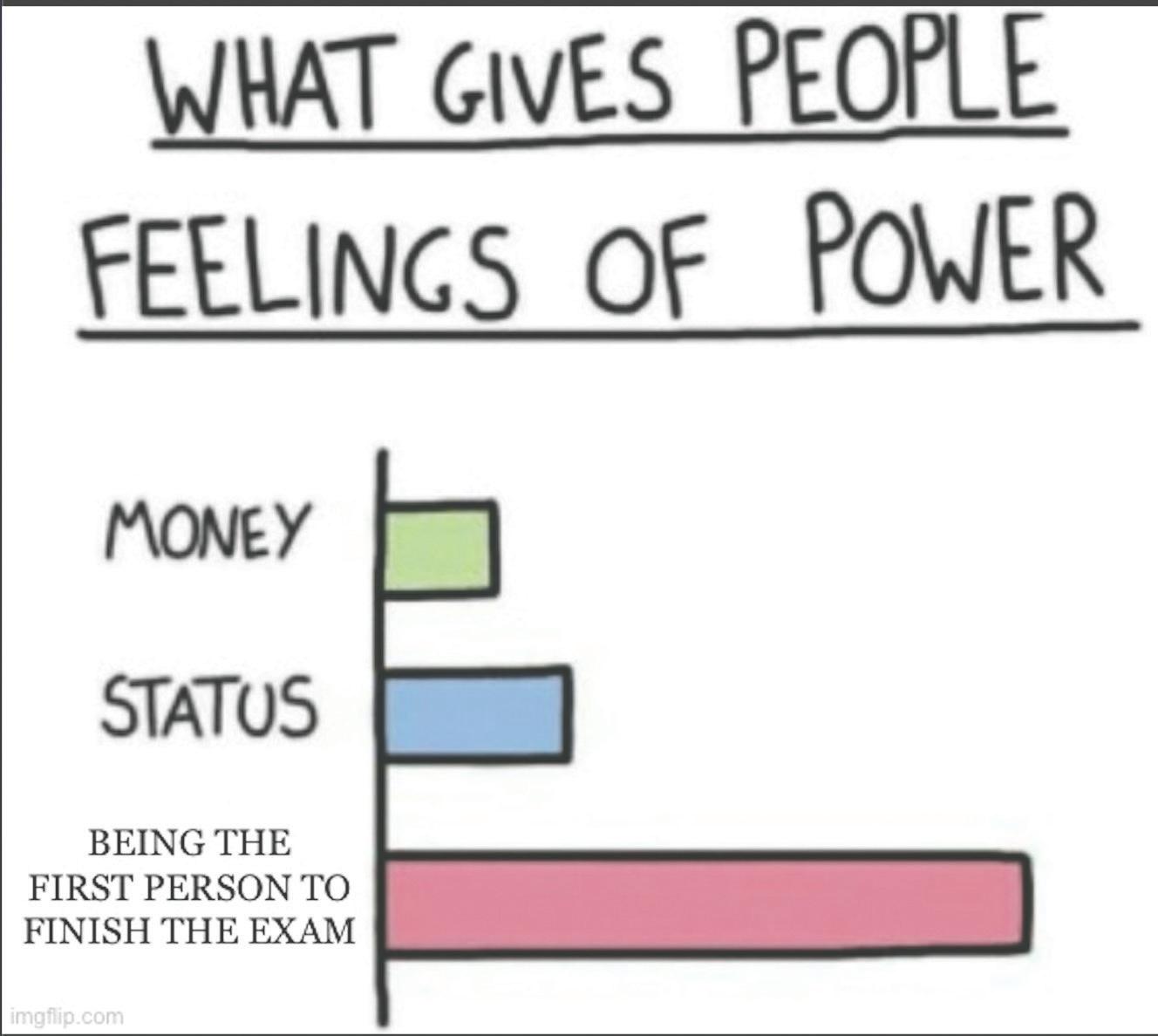



So Right You’re Wrong @peter_isaiah_poetry Tweet Cute @peter_isaiah_poetry Speeding Through Scantrons @laney_bonora Solution to last week’s puzzle 75 to 7.5 Overnight @laney_bonora Professor Plea @peter_isaiah_poetry Subtle Differences @dundadre Monday, April 3, 2017 Thursday, September 28, 2017 Monday, October 2, 2017 Thursday, October 5, 2017 Tuesday, November 22, 2022 F UN
BUMP brings dreamy and electronic beats to BU
shows to see at the school.”
Revati Gelda Arts & Culture Intern
This past Thursday, the Binghamton University Union Underground Cafe was the place to be as students came together for the newest Binghamton Underground Music Presents (BUMP) show — featuring Blue Hawaii and opener DJ Ambrosia.

Blue Hawaii consists of Raphaelle “Ra” StandellPreston and Alex “Agor” Cowan. They are known for their dreamy and electronic beats. Sonically, they take inspiration from ‘90s dance music, while their lyricism speaks to their emotional vulnerabilities surrounding the complexities of love, heartbreak and separation.
Madeline Schalk, BUMP chair and a senior majoring in economics, described her reasoning behind bringing Blue Hawaii to BU.
“I had been listening to Blue Hawaii for a few years now,” Schalk said. “My sister introduced me to the group and I wanted to get a very high-energy performance that would get the crowd going. They also did the best on our fall survey for BUMP
The Underground Cafe was transformed by way of mood lighting that illuminated the space in a mixture of deep purples, greens and blues. Along with the eclectic lighting, the intimate setting allowed both performers to truly hone in on their music while connecting it to the audience.
DJ Ambrosia’s highenergy infused set was a total body experience, as you could quite literally feel the vibrations of the music within your chest. The combination of their killer beat drops, heavy bass and dream-like tones throughout their set made for an impactful opening for the audience.
DJ Ambrosia, also known as Genie Fyodorova — a senior majoring in biology — reflected on the focus they tap into before a performance.
“You look at the crowd and you see how the crowd is feeling and you respond to that,” Fyodorova said. “You look at how they’re doing and what they’re vibing with and pick your next song from there. I try to be very deliberate with my song choices.”
When Blue Hawaii took
the stage, they continued to build on the energy that DJ Ambrosia had started. Their opening song “L.O.V.E.” — off of their 2022 EP “My Bestfriend’s House” — introduced the crowd to Standell-Preston’s ethereal vocals and Cowan’s DJ skills. They continued their set by playing their 2020 EP “Under 1 House,” which included “Let it Be Us” — a song that started off stripped down but slowly built the bass under Standell-Preston’s vocals, exuding a longing feeling of intense love. Their third title track off of this EP, “Not my Boss!” got the crowd going as they shouted back the lyrics “You’re not my boss!” and “I’m my own damn woman.” The duo’s electric presence on stage shined when StandellPreston performed “I Felt Love,” which created an entrancing mood that was felt among the crowd.
Standell-Preston said Blue Hawaii represents a joyful experience for her.
“It’s something that we do very quickly, that we do naturally, very joyfully and very easefully,” StandellPreston said. “That’s something that I definitely honor very much within my working relationship with Agor. Bringing joy and ease
to the process and seeing that within the audience of people letting loose and letting their guard down and us letting our guard down.”
As their set came to a close, the duo began to improvise and even played
Britney Spears’s “Toxic,” which continued their ability to produce a space of infectious dancing all the way until the end.
According to Schalk, the night was a success.
“Blue Hawaii was really
good at outreaching the crowd and making everyone feel really comfortable, really empowered and really good about themselves,” Schalk said. “I think that reflected in the dancing everybody did.”
Dance lessons and performances brought to students
from page 1
After a buffet-style dinner arrived, a performance began from BU’s very own Explorchestra — which performed orchestral versions of three pop hit songs. Zoë Rose, a viola player for Explorchestra and a sophomore majoring in biochemistry, discussed the band’s change to a pop music performance.
“This was the first time we broke down into a smaller group and played more pop music instead of original music,” Rose said. “We pulled it together over the last few weeks and it went well.”
Next on the agenda were four unique performances from members of the ballroom team. First up was a vocal
performance of “So This Is Love,” and afterward came a Latin rumba and pasodoble performance by two team members.
The subsequent performance was perhaps the most elaborate of the night, as Efe Cankat Turkmen, a member of the team and a first-year graduate student studying computer science, danced to Rihanna’s “S&M” and “Umbrella” in the vein of Tom Holland’s viral performance on “Lip Sync Battle.” Turkmen said it was his dream was to perform the dance after watching it on television.
“Our captain came to me and asked if I wanted to do the Tom Holland ‘Umbrella’ performance and I said definitely yes,” Turkmen said.
The last scheduled performance was a Viennese waltz to the “La La Land” soundtrack performed by Michelle Baginski, programming coordinator for the team and sophomore majoring in accounting, and Justin Frank, another member of the team and a sophomore double-majoring in chemistry and theatre.
Baginski was one of the key people behind putting the event together. She said her experience training with Frank was not without its slip-ups.
“When I was practicing with [Frank] the other day for our waltz, I was running and I slipped and fell while I was trying to get his arm and he slipped with me, so that shows our partnership,” Baginski
said.
At the end of Baginski and Frank’s performance, all of the event’s attendees were invited to come onto the dance floor and get a lesson on how to waltz. The lesson was geared toward beginners and focused on the basic footwork of the dance. Rose described the lesson plan as a success.
“They did a fantastic job of breaking the waltz down for everybody,” Rose said. “It was a great balance between the team performances and including the other attendees of the ball.”
By giving all attendees the opportunity to learn dance, the team broke down the barrier between members of the ballroom team and attendees who were there to see the performances. Brian Flynn, a
senior majoring in biomedical engineering, came to the event with little experience in dance.
“Dance has always been something that I have been interested in, but never decided to take it as a hobby,” Flynn said. “Up until this point, ballroom dancing has been something I have considered to be exclusive or elitist and not for someone like myself, but that is exactly what the event was trying to combat.”
Although not on the official agenda for the event, the two masters of ceremonies of the event — Steven La, competition coordinator for the BBDA team and a senior majoring in biomedical engineering, and Jason Yang, another team member and a sophomore majoring in computer science
NSA hosts the 2022 Acalympic Games
Collegiate Center. Former NSA member Craig Bottner, ‘22, found that the video captured the essence of the group.
If you have not yet heard of the 2022 Acalympic Games, acascuse me? In the great words of “Pitch Perfect 2,” let’s talkapella.
No Strings Attached, or NSA for short, is Binghamton University’s very own Disney/ Broadway a cappella group, one of 10 official a capella groups at the school. NSA performed their biannual semester show on Saturday, Nov. 19, capturing a whole semester of hard work in one aca-motional night.
The performance featured 10 a cappella songs sung by the NSA, and an Olympic-themed video starring its members. The video was broken down into four parts that were interwoven between the songs.

The videos were centered around the fictional 2022 Acalympic Games, featuring competition between the rival red and blue teams. Although the red team got out to an early lead and attempted to take out members of the blue team with unethical strategies, the blue team ended up coming back to win in the final competition of the games — the couch bench.
The video was humorous and parodied “Rocky” by including a training montage that ended with two characters running up the stairs to Appalachian
“We have not seen some of these guys in a while so it is nice to see them having fun and doing all their inside jokes,” Bottner said. “It’s great to see all of their personalities come out in the video.”
The first song of the night was “Wait For Me” from the show “Hadestown.” It featured three solos from Jenna Zipparo, NSA president and a junior majoring in integrative neuroscience, Isabella Scarpati, who serves as both public relations director and assistant music director for NSA and is a senior majoring in psychology, and Paul Lloyd, vice president for NSA and a junior majoring in psychology. The song got the group off to a strong start. Alanah Fitzgerald, a junior double-majoring in math and economics, found it to be one of the highlights of the night.
“The music is so beautiful and I love when [Zipparo] stands on the stage,” Fitzgerald said. “[Lloyd] does really well in it too.”
The show continued with songs from “Pocahontas,” “Mean Girls the Musical” and “Beauty and the Beast.” In particular, “Gaston” was a standout, as Logan Rehberg — the treasurer for NSA and a junior majoring in integrative neuroscience — who played Gaston himself, captured the heart of the character with his voice and mannerisms.
The final song of the first
half of the show was the song “Phantom of the Opera” from — you guessed it — the show “Phantom of the Opera.” Zipparo’s ability to hit high notes was on full display and had the audience on the edge of their seats. Kelly Wang, a junior majoring in integrative neuroscience, found that this performance did the song justice.
“The highlight of it especially was the high notes where Gerard’s character in the movie wanted her to sing so they mimicked that and I really enjoyed it,” Wang said.
NSA came out of intermission with songs from “Waitress” and “The Hunchback of Notre Dame,” before getting to “Disney Villains Medley,” combining songs from a variety of movies. Ursula, Scar and Dr. Facilier competed on stage for the audience’s attention. Justin Frank, theatre and music director for NSA and a sophomore majoring in chemistry, portrayed Dr. Facilier. Frank said this song summed up the essence of the show.
“We start with the main Disney but we get to dive into this villainous character we love from
our childhood,” Frank said. “Dr. Facilier, in particular, is unique because of his showmanship.”
The penultimate song of the night was “Kiss the Girl” from “The Little Mermaid.” All of the NSA alumni in the crowd were invited to come up and sing along with the current members. As the alumni came up and hugged the current members, it was clear that NSA is more of an aca-family than just an a cappella group. Frank said he enjoyed singing along with the alumni.
“Getting them back on stage for our alumni song was really
— performed their own “fun” dance along with Christopher Thomas, competition coordinator for the BBDA and a sophomore majoring in integrative neuroscience. La discussed his favorite moment of the event.
“We had been working on that all week, but it was kind of nerve-wracking at the start because we felt a little underpracticed, but once it came down to it we did a good job,” La said.
The event ended with an open dance time for all attendees to dance along to popular songs. On the whole, the Royal Ball was a smashing success that brought the regal aspect of ballroom dance to BU while showing the fun and silly side of the sport as well.
such a joy because I did miss singing with them,” Frank said.
Finally, the show ended with “From Now On” from the movie “The Greatest Showman.” The song combined elements of “From Now On” and “Rewrite the Stars” to create an emotionally powerful melange that ended the show on a high note, pun intended. It was clear that NSA had won the heart of the crowd with their comedic videos and beautiful singing, as the crowd rose for a well-earned standing ovation to end the night.
The show featured Blue Hawaii, with DJ Ambrosia opening.
kai depalma contributing photographer
Blue Hawaii’s music is influenced by ’90s dance music and focuses on themes of love and heartbreak. ball
eli engler assistant arts editor
The event took place last Saturday at Lecture Hall 2.
Culture editor
NSA performed songs such as “Gaston” from “Beauty and the Beast.”
Eli Engler assistant Arts &
Elizabeth Mozer stuns in her one woman show
Mozer performed “The Asylum Project.”
This past Tuesday, the Binghamton University Arts Museum presented a onewoman show called “The Asylum Project,” written and performed by Elizabeth Mozer, an associate professor in the theatre department.

The performance took place in the main gallery of the Fine Arts Building, which houses the exhibit “Michal Heiman: Chronically Linked.” The show is based on the lives of Agnes — a Polish immigrant — psychiatric hospital patients Rose, Willa and Bonnie and Lina, the child of Agnes. Mozer draws from personal accounts, historical documents and imaginings to create a fictionalized world of asylum experience within the context of real-life stories within these characters.
The solo performance aimed to focus the narrative on Agnes and her experience in the asylum after being separated from her daughter due to a traumatic
house fire. Both believed the other had died. However, unknown to Lina, her mother had survived, becoming a patient at the Binghamton State Hospital for decades. It wouldn’t be until 64 years after their separation that the two would reunite. In this performance, Mozer transforms back and forth between the three patients of the asylum throughout the play and portrays their perspectives on Agnes’ condition. Drawn from personal accounts, historical documents and imaginings, stories that were once silenced are now given voice by Mozer’s captivating performance.
Mozer described her inspiration behind “The Asylum Project.”
“I had the pleasure of taking a tour of the asylum in 2015 with other faculty members,” Mozer said. “The woman who was giving me the tour shared a particular story with me while I was there that captured my heart, soul and imagination for years to come and fueled me to do the research and the creative work that I did to create this piece.”


The piece is broken up into
three separate scenes where we follow the inner thoughts of Rose, Willa and Bonnie. Mozer crafted each character to have specific movements that were distinguishable to them and reflected their personality. The audience was invited into three separate, intimate spaces to see these characters express their experience in the asylum while simultaneously giving their perspective on Agnes’ mental state.
Mozer explained the process of bringing these characters to life.
“I am interested in physical dramaturgy — how people move and how that relationship between the outer behavior and the inner life are connected and how the two feed each other,” Mozer said. “Having a really clear physical life helped anchor me as the actor to navigate and do those transitions quickly.”

Mozer continued to emphasize the importance of finding inspiration for her play within a historical context.

“All that life and history was really present in the building, and it was very moving to me,” Mozer said. “I felt different after
having been there and then learning the remarkable story about Agnes.”
Claire Kovacs, the curator of collections and exhibitions at BU, described “The Asylum Project’s” connection to Heiman’s exhibit as both pieces working together to explore the practices that go on within an asylum. In addition, Kovacs said the pieces break down the complex identities of individuals who experience such practices. There is also a visual similarity, as Mozer wears a dress that is akin to the outfit in Heiman’s art piece known as the “Dress Project.”
Mozer’s performance in “The Asylum Project” is one that is filled with a genuine interest in the lives of these individuals. She captures their emotions and mannerisms in a way that will leave the watcher with a deep insight into a few experiences of asylum patients.
“When I heard this real-life story, this remarkable journey of love, you know, love across time, place and circumstance coming together, it was worthwhile in getting to explore that,” Mozer said.
bupipedream.com | November 22, 2022 ARTS 8
sourced from sourced from the ithaca journal
“The Asylum Project” follows a Polish immigrant and her daughter alongside three other asylum patients.
Revati Gelda Arts & Culture Intern
Men’s basketball falls at home to Sacred Heart
in from the opposite side, which we’ve been doing all season.”
Despite their struggles, the Bearcats began the game on a 12-1 run as the Pioneers didn’t score their first field goal until six minutes had ticked off the clock.
On Saturday afternoon, the Binghamton men’s basketball team suffered its second loss of the season at home against Sacred Heart. Despite a hot start to the first half, BU struggled to get things going offensively and failed to get defensive stops in crucial moments. At the sound of the final buzzer, it was SHU that ended up on top, defeating the hosts 75-60.

“I thought we had some opportunities to shoot some open shots that we didn’t take,” said Binghamton head coach Levell Sanders. “Then we started dribbling it and tried to drive into a crowd, which made our offense stagnant.”
Both BU (2-2) and SHU (32) came into the game looking to get back into the win column — as both teams were defeated in their previous matchups. The Bearcats never found their groove on offense, shooting 39 percent from the field and just 4-20 from beyond the arc. Despite struggling on offense in the first half, the Pioneers turned things around in the second, shooting 48.6 percent from the field while draining five three-pointers.
“We built a little lead but then our offense got stagnant,” Sanders said. “We couldn’t get the ball inside because they were fronting us. We didn’t get guys flashing
BU distributed the ball early on as its ball movement led to early baskets from junior guard John McGriff and graduate student guard Christian Hinckson. SHU soon picked up the pace, however, going on a 17-7 run and knotting things up at 19 nearing the end of the half.
Binghamton responded as graduate student forward Miles Gibson knocked down a threepointer, giving the Bearcats the lead — which was extended with a layup on the next possession.

The home team’s defensive woes continued, however, as the Pioneers ended the half on a 10-0 run to lead 29-24 at the break.
“We’ve got to get better offensively,” Sanders said. “That’s sharing the ball, taking better shots … We’ve got to offensive rebound a little more when our shots aren’t going in. We couldn’t score and that’s kind of been the theme for us … [In the] half court we’ve been struggling to score.”
The Bearcats found themselves down five at the break as they struggled after surrendering their early lead to SHU. BU shot 34.6 percent from the field and 22.2 percent from three in the half, and had 13 turnovers that led to 13 points for SHU.
“I didn’t think we were bad defensively, [SHU] only scored 29 points in the first half, but we only had 25,” Sanders said. “If you turn the ball over 13 times in the
first half, that’s 13 times you don’t even get to shoot the ball.”
SHU built on its first-half momentum, drilling a threepointer to get the second-half scoring started. The Pioneers would go on a 10-2 outburst to start the period as BU’s defense allowed three three-pointers to start the half. Just before the 10-minute mark, Sacred Heart took a 22-point lead, its largest of the game. The Bearcats attempted a late comeback with back-to-back lobs to senior guard Jacob Falko
and eventually cut their deficit to 11, courtesy of a fast-break layup by sophomore guard Matt Solomon. However, BU’s window of opportunity began to close as the clock winded down and the Pioneers still held the lead.
“We were trying to get [Falko and McGriff] to rebound and push the ball in transition to get those open opportunities because it seemed like that was our best offense when we got it out and ran,” Sanders said. “We’ve got to get those guys
to force [the] tempo … Create opportunities for themselves, but also create opportunities for their teammates.”
Despite containing SHU’s junior guard Nico Galette early on in the first half, the Bearcats struggled to tighten their defense on him in the second. Galette propelled the Pioneer offense with 26 points and nine rebounds while shooting 9-18 from the field and 4-7 from beyond the arc.
“I thought [Hinckson] did a good job on [Galette] early on,”
Sanders said. “But with a good offensive player like that … he was making some tough shots … and once again when you give a guy an opportunity to see the ball go into the basket, they become more confident — and that’s what we didn’t want this team to do.” BU will host Columbia at home in its next matchup on Wednesday, Nov. 23. Tipoff is set for 2 p.m. at the Dr. Bai Lee court in Vestal, New York.
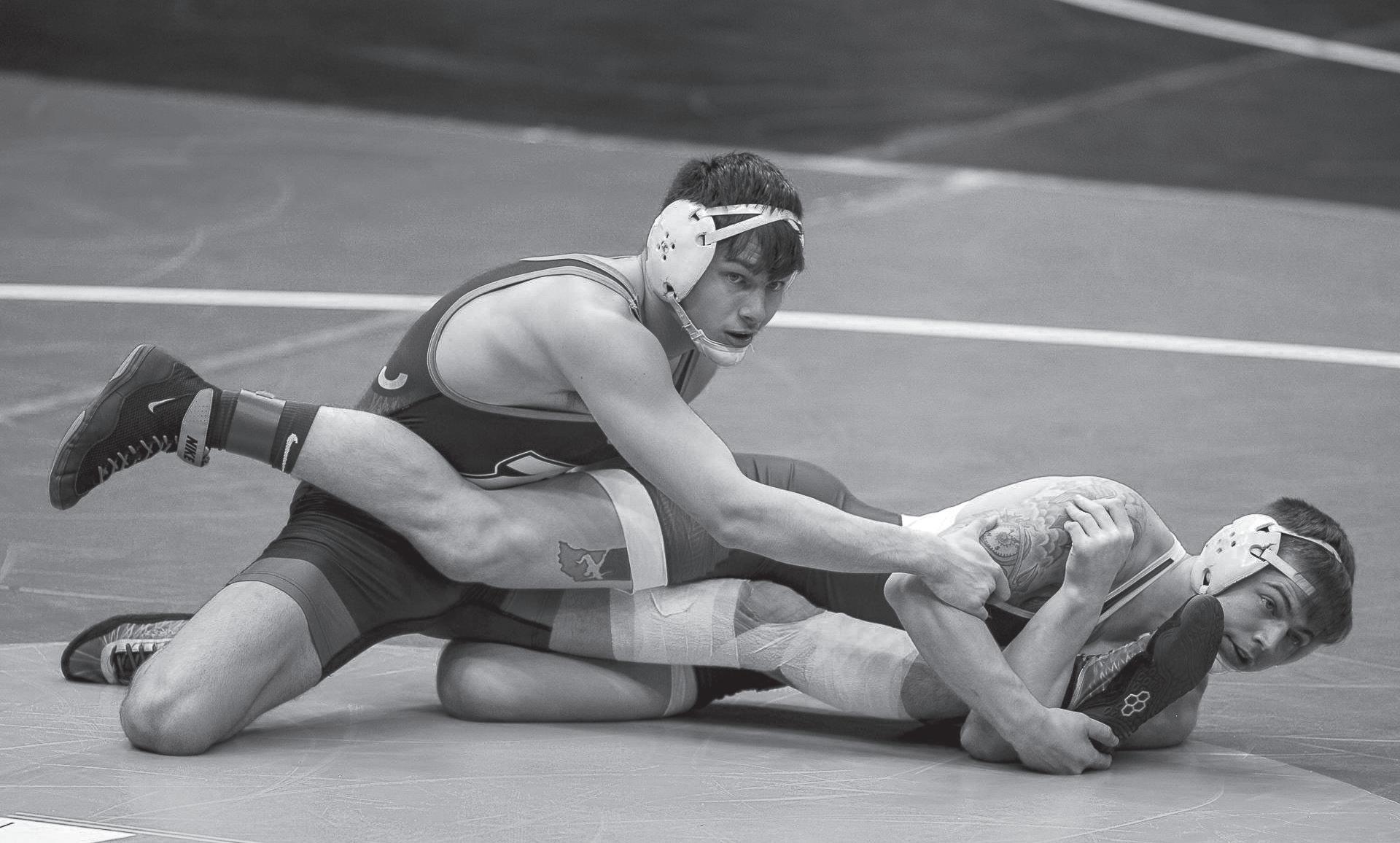
Wrestling drops weekend battles with ranked opponents
BU loses back-to-back matchups against No. 18 North Dakota State, No. 11 Minnesota.
Aidan Jennings sports intern
Over the weekend, the Binghamton wrestling team made the trip to North Dakota and Minnesota for two dual meets. Despite big wins in both meets from redshirt junior Jacob Nolan and graduate student
Lou DePrez to keep it close, the Bearcats were unable to overcome No. 18 North Dakota State nor No. 11 Minnesota, with the meets resulting in 18-13 and 19-15 losses, respectively.

“Every dual meet we’ve lost by one match, and the matches that we’ve lost, we’ve had some one-point losses,” said Binghamton head coach Kyle Borshoff. “So at the end of the day we wrestled the [11th] ranked team in the country, we wrestled the 18th ranked team in the country and we
were a one-point loss away from winning those duals. So we have a lot to build on, you know, it’s frustrating to lose.”
BU (0-3) first matched up with NDSU (2-0) on Friday in a meet that started off slowly for the Bearcats. Binghamton dropped six of its first seven bouts. A late comeback push from the visitors saw the Bearcats claw back with three straight wins. The late push was not enough for BU as the meet ended in an 18-13 defeat. Redshirt freshman Nate Lucier
grabbed a win in his second career dual meet, winning 7-5 after a takedown in the third period in the 141-pound weight class.
The late pressure, however, was helped on by wins from Binghamton’s competitors in the heavier weight classes. Nolan, at 184 pounds, started off his winning weekend with a takedown in the third period to defeat his opponent, ranked No. 29 in the nation, 3-1. L. DePrez and redshirt junior Cory Day also secured their second wins of
the season in the 197-pound and heavyweight classes respectively. L. DePrez had three takedowns in his victory. Graduate student Michael Zarif was also among the winners against the Bison, being the only Bearcat in the meet to pick up bonus points in his 13-4 major decision win in the 149-pound class.
“Jacob Nolan had a great weekend,” Borshoff said. “He beat the guys ranked 10th in the country and 29th in the country. [L.] DePrez beat the 28th and 29th ranked guys in the country. Day had two huge wins at heavyweight, beating starters from Minnesota and North Dakota. Those three guys had a great weekend. Nate Lucier got his first dual win for us today against Minnesota. Zarif [was] wrestling hard, got a nice win against North Dakota. So overall, I think we’re wrestling hard, but we’ve lost three dual meets.”
In their second meet of the weekend, the Bearcats once again clawed their way back from an early deficit after going down 6-0 against Minnesota (10). With two bouts remaining, however, Binghamton found itself with a 15-12 lead.
The last two bouts were taken by the Gophers, with the home team wrapping up a 1915 victory in the end. Lucier was a standout performer, winning the first dual match of his career with a 9-7 comeback win after being down 5-2 in the final period. Day and DePrez also won once again, rounding out unbeaten weekends for both wrestlers and improving their
records to 3-0 across the board.
Nolan was also once again among the winners, this time taking down No. 10 Isiah Salazar. As Nolan maintained a 4-2 lead with nearly a minute left in the second period, Salazar brought it back to 4-4. Nolan gained a 5-4 lead early in the third period, holding his opponent off for the remaining time to remain undefeated and grab an upset win.
“We’ve always known that [Nolan] is an incredible wrestler, and he’s starting to show it to everyone else,” Borshoff said. “So really happy with how he’s been doing and looking forward to next weekend.”
Despite having to make the long journey home, still winless, Binghamton has kept every matchup tight so far this year. Both meets this weekend saw the Bearcats bring it to a close finish after trailing early. In addition, all of BU’s meets this year so far have been decided by six points or less. Nolan came into the weekend ranked 22nd in the nation with DePrez at seventh within their respective weight classes.

“It’s not what I’m going to do, it’s what the team’s going to do,” Borshoff said. “Someone’s got to figure it out … I don’t have any expectations. We need guys to step up and win matches. Need guys that have been losing to step up and win matches.”
Binghamton will continue its season on Sunday, Nov. 27 against Buffalo. First bout is scheduled for 7 p.m. at the Alumni Arena in Buffalo, New York.
bupipedream.com | November 22, 2022 SPORTS 9
Binghamton drops second straight matchup.
Johnny Yang sports intern
mason brody-lewis assisstant photo editor
Senior guard Jacob Falko scored 15 points in Binghamton’s 75-60 loss against Sacred Heart on Saturday.
provided by justin hoch
Redshirt junior Jacob Nolan defeated the No. 10 wrestler at 184 pounds in BU’s dual meet against Minnesota on Sunday.
Volleyball upset by UNH in America East semifinals
The hosts countered immediately with three straight points of their own, courtesy of two kills by first-team all-conference junior outside hitter Stefana Stan. Stan tallied six kills in the first set alone and finished the match tied for a team-best 11 kills.
“We can always rely on [Stan],” Yaeger said. “The things that she does when you only come in and play three rotations — she does exactly what we need her to do. She passes well, she hits well [and] she blocks well.”
The back-and-forth effort continued for the remainder of the first set, with both teams going on mini-scoring runs. Eventually, the
Bearcats found themselves up 2321, approaching a set one victory, but UNH staged a late-game 3-0 run to take a 24-23 advantage.
Both sides traded points before the Wildcats, who found themselves down 28-27, tallied three straight kills to take the first set 30-28.
In set two, BU got out to another slow start, falling behind 6-1. However, the Bearcats did not give up as they strung together two separate 4-0 runs to tie the game up at 10-10. This was yet another back-and-forth set, as both teams went toe-to-toe with each other.
The score ended up being tied at 20, but Binghamton was unable to neutralize the UNH offense as it lost 25-23 in the frame.
“It’s tough going into a match
where we didn’t have a lot of time to prepare with that lineup,” Yaeger said. “I thought [junior setter Jessie Bilello] did an outstanding job coming in … But that New Hampshire team, they wanted it, and it’s hard to beat a team three times in a season.”
In hopes of a comeback, Binghamton began the third set with a 5-3 lead. However, that was the last lead BU held for the remainder of the set as the Wildcats capitalized on nine Bearcat errors in the set. Offensively, most of the contributions came from Stan and AE Player of the Year junior outside hitter Tsvetelina Ilieva. The pair each had 11 kills on the day to lead BU.
Additionally, Binghamton’s
defense played a major role in the match as the team totaled nine blocks on the day, with five coming from senior middle hitter Anna Sprys. It was not enough, however, as the Bearcats lost the third set 2516, ending their AE title hopes.
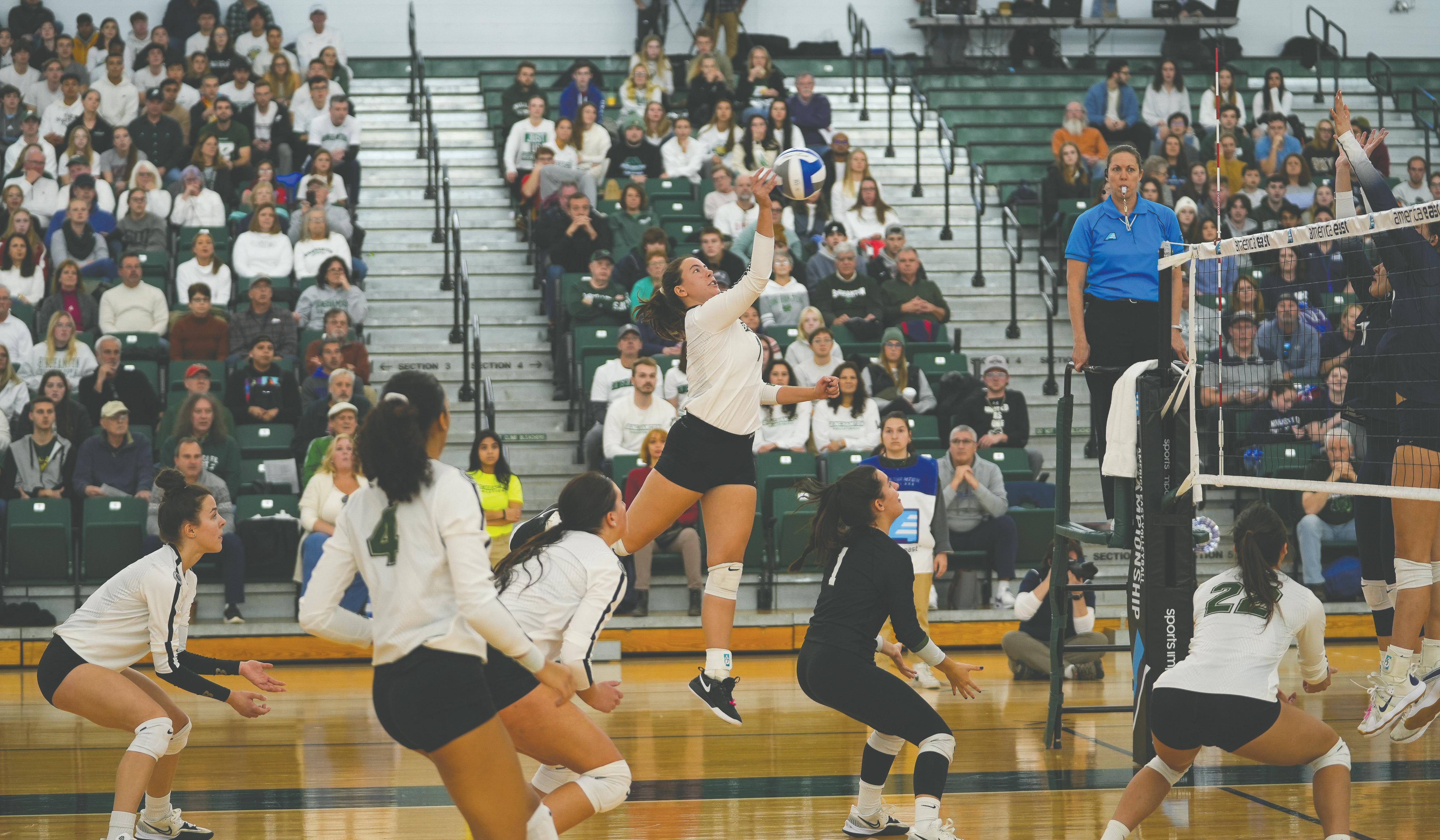
“We were still able to put the ball away,” Yaeger said. “That’s something that we never stopped doing the whole match … We can’t forget the good stuff that we did, and we took some big swings at big times. It got to the point where we had to have a sense of urgency, especially when we’re down 2-0 … But we were able to put the ball away, we did that well, and blocking has always worked for us, so that was good too.”
As a team, BU earned an array
of AE season awards. Led by Yaeger, Binghamton’s coaching staff earned Coaching Staff of the Year honors for their first-place finish in the conference this year. Furthermore, the Bearcats earned a league-high five all-conference awards, including Ilieva who was the unanimous choice for AE Player of the Year. Stan joined Ilieva on the first team while Sprys, Scully and freshman outside hitter Giulia Bonifacio took second-team all-conference selections.
“It’s a team effort,” Yaeger said.
“All of them coming together and learning how to play as a team and building a new culture … So many new faces, new coaching staff and to be able to put out on the floor what we have all season long, I’m so
proud of every single one of them. There’s a lot of individual awards that they got, [but] they couldn’t have done that without the rest of the team.”
Despite the conference season now coming to a close, BU’s season will continue. After capturing the AE regular season title, the Bearcats earned themselves a spot at the National Invitational Volleyball Championship (NVIC). The NVIC is a 32-team tournament whose bracket will be unveiled on Nov. 27.
“Season’s not over,” Yaeger said. “I think [the NVIC] is a great opportunity too for these kids to see what postseason is like, keep them competing into December and help us for the future.”
Women’s basketball earns close win against Canisius
Bowman blocks potential game-tying shot as time expires.
Oh sports editor
With a last-minute postponement due to a snowstorm, the Binghamton women’s basketball traveled to Buffalo, New York to take on Canisius on Sunday. After hitting two free throws with six seconds left in the game, senior guard Denai Bowman sealed the 75-72 victory, blocking the Griffs’ last-second attempt.
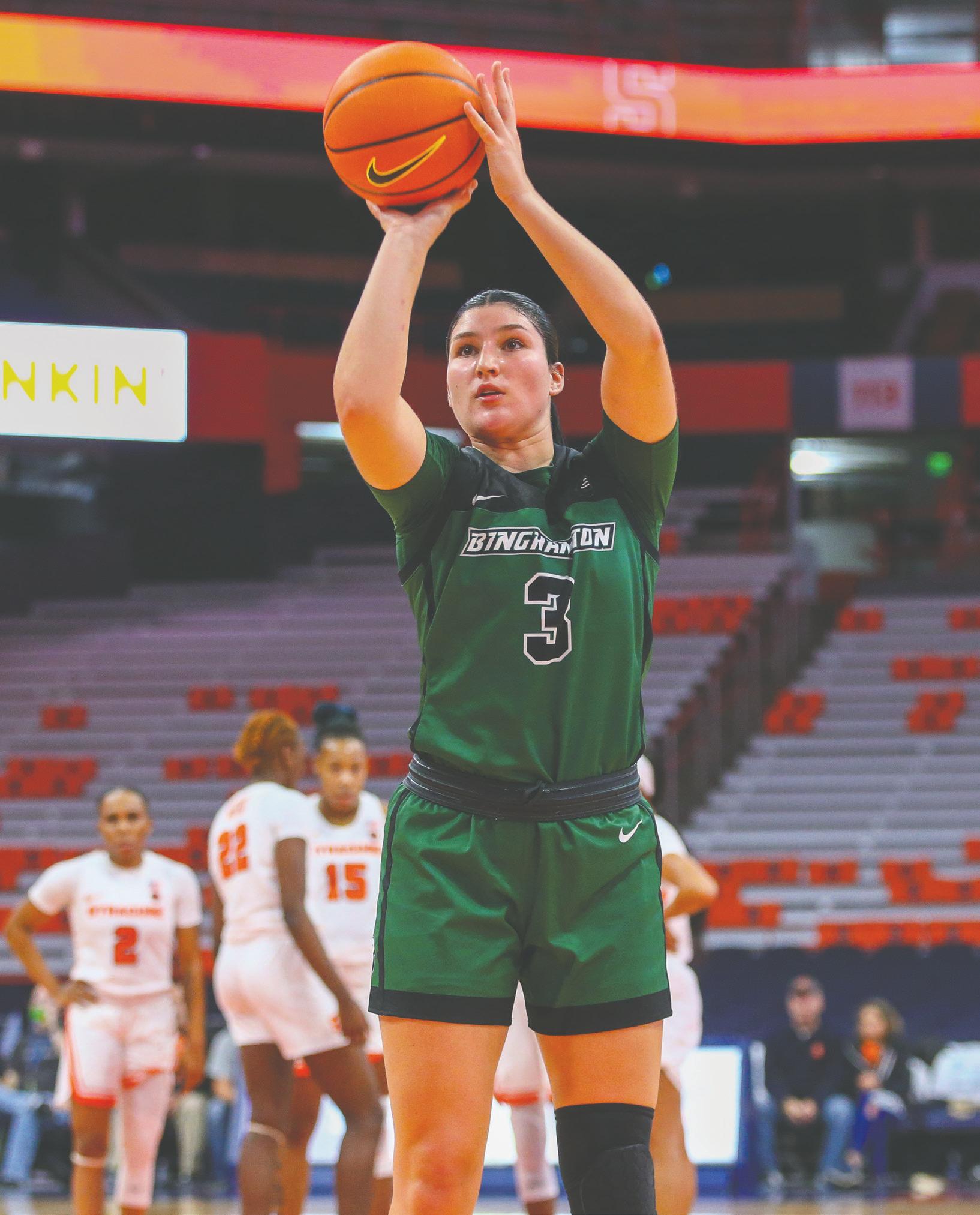
“I was so proud of the way they kept their composure at the end of the game,” said Binghamton head coach Bethann Shapiro Ord. “Our defense really did a tremendous job of getting stops at the end when we really needed it to win the game, so that was huge.”
Both teams struggled to score to start the game. However, redshirt freshman guard Ella Wanzer scored BU’s (4-1) first eight points, including two three-pointers, which gave the Bearcats an early 8-2 lead. This did not last, however, as Canisius (1-2) put together a 7-0 run to take the lead. For the rest of the quarter, both teams traded baskets and at the end of the period the score was tied at 15.
“[Wanzer] was tremendous,” Shapiro Ord said. “I knew she was gonna have a great shooting game because her family was there, and she grew up going to camps and stuff there. She’s
been in that gym a lot as a kid … I knew her shot was going down.”
The second quarter saw a higher offensive output from both sides. Senior guard Clare Traeger tallied five points in a row as BU went up 31-24. Canisius responded promptly with an 8-0 run to regain its lead. After Wanzer regained the lead with a fast-break three-pointer — and less than a minute before halftime — Bowman sized up a Golden Griffin defender with a crossover dribble followed by a step back. As the defender stumbled back, Bowman rose up and hit the mid-range jump shot and the Bearcats headed into the break up 36-34.
“We were getting up and down in transition,” Shapiro Ord said. “We had a lot of fastbreaks. It was an up-tempo game for sure and a lot of lead changes, but that was the biggest thing, being up-tempo.”
Coming out of halftime, both teams began to apply pressure offensively, scoring 25 points each in the penultimate frame. The Griffs capitalized on their second chances, scoring eight points off of second chance opportunities in the period.
“Just keeping our composure like we have, that’s something great to build on,” Shapiro Ord said. “We need to continue to just not allow anybody else to have second chance opportunities, which we gave [Canisius]. They had 12 points off of second chance opportunities.”
The fourth quarter was more defensive-minded, as the
Bearcats and Griffs scored 14 and 13 points, respectively. The back-and-forth nature of the game was prevalent as there were 16 lead changes throughout. As the game drew to a close, BU was able to edge out Canisius — courtesy of Bowman who scored the team’s last five points. Additionally, she registered the gamewinning block on Canisius’ final possession to secure the 75-72 win for BU.
“Winning on the road like this is huge,” Shapiro Ord said. “It might’ve been ugly at times, but guess what, we got the W … If we didn’t miss a few layups and turned it over a little bit, it would’ve been a different game.”
Four separate Bearcats scored in double figures. Wanzer led the way with 19, shooting 5-for-8 from threepoint range, Bowman had 16, Traeger had 12 and sophomore forward Genevieve Coleman finished with 10. Traeger had 10 rebounds as well, earning her second double-double of the season. The senior is averaging a career-high 10.8 rebounds per game. Redshirt freshman guard Jadyn Weltz dished out six assists.
“Clare Traeger did great again, having a double-double,” Shapiro Ord said. “She’s still a beast on the boards.”
BU will return to action on Friday, Nov. 25 to compete in the Florida Atlantic Thanksgiving Tournament with its first game against FAU. Tipoff is set for 4 p.m. at the Abessinio Court at FAU Arena in Boca Raton, Florida.
Tuesday, November 22, 2022 STREAM ON SPOTIFY Pipe Dream Bearcast
Jack
mason brody-lewis assisstant photo editor
Junior outside hitter Stefana Stan tallied 11 kills in BU’s 3-0 semifinal loss in the AE tournament against UNH on Saturday.
provided by micheal j. okoniewski
Redshirt freshman guard Ella Wanzer scored 19 points in BU’s 75-72 victory against Canisius on Sunday.
volleyball
from page 1











































